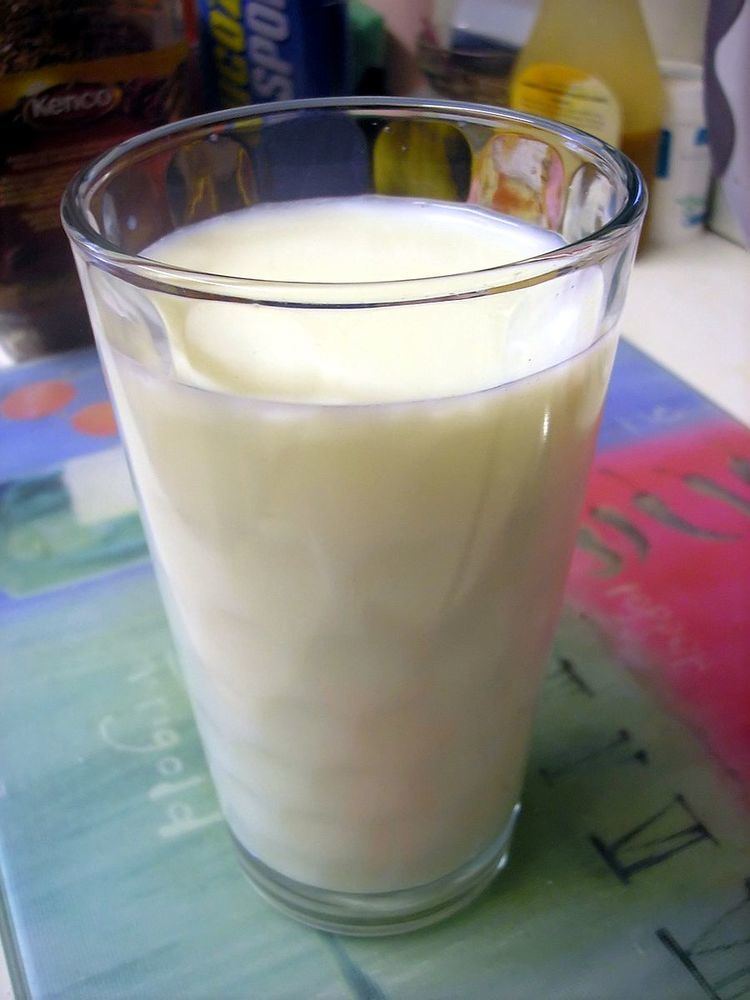ICD-9-CM 995.3, V15.02 | ||
 | ||
A milk allergy is a food allergy, an adverse immune reaction to one or more of the constituents of milk from any animal (most commonly alpha S1-casein, a protein in cow's milk). This milk-induced allergic reaction can involve anaphylaxis, a potentially life-threatening condition.
Contents
Classification
Milk allergy is a food allergy, an adverse immune reaction to a food protein that is normally harmless to the nonallergic individual.
It is distinct from lactose intolerance, which is a nonallergic food sensitivity, due to not enough of the enzyme lactase in the small intestines to break lactose down into glucose and galactose.
Signs and symptoms
The effects of antibody-mediated allergy are rapid in onset, evolving within minutes or seconds. These allergies always arise within an hour of drinking milk; but can occasionally be delayed longer when eating food containing milk as an ingredient. The effects of non-antibody-mediated allergy is delayed; because it is not caused by antibodies, it can take several hours, or even up to 72 hours to produce a clinical effect. The most common symptoms for both types are hives and swelling, vomiting, and wheezing, with symptoms first arising in skin, then the GI tract, and less commonly, the respiratory tract. Milk allergy can cause anaphylaxis in about 1–2% of cases, which is a severe, life-threatening allergic reaction.
Mechanism
The major allergens in cow milk are αs1-, αs2-, β-, and κ-casein and the whey proteins α- and β-lactoglobulin. The body may raise an antibody-based immuneresponse or a cell-based immune response to these allergens. The reaction to cow milk is caused by IgE and non-IgE mediated responses, with the latter being the most frequent. The non-IgE reactions involving the gastrointestinal tract are typically delayed while IgE reactions such as hives are much more immediate.
Diagnosis
Diagnosis is carried out by first doing a diagnostic elimination diet, skin prick tests, measuring IgE in blood, and conducting in-office food challenges. A double-blind, placebo-controlled food challenge is still the gold standard for the diagnosis for all food allergies, including milk allergies. A negative IgE test doesn't rule out antibody-based allergy (in the case of false negatives), or cell-mediated allergy. Therefore, double-blind, placebo-controlled food challenge is important to rule out this form of allergy.
Management
The main treatment for milk allergy is avoiding dairy products; because these proteins can be found in breast milk, nursing mothers should also abstain from dairy products prior to weaning.
Because proteins in various mammalians are often cross-reactive, other forms of milk should not be substituted.
Milk substitute formulas are used to provide a complete source of nutrition for infants. Milk substitutes include soy-based formulas, hypoallergenic formulas based on partially or extensively hydrolyzed protein, and free amino acid-based formulas. Nondairy-derived, amino acid-based formulas (elemental formulas) such as Neocatem, EleCare, and Puramine, are considered the gold standard in the treatment of cows'-milk allergy when the mother is unable to breastfeed. Milk substitutes from soy, nuts, and the like should not be considered as they are not nutritionally equivalent.
The elimination diet should be tested every six months by testing milk-containing products low on the "milk ladder", such as fully cooked foods containing milk, in which the milk proteins have been denatured, and ending with fresh cheese and milk.
Accidental exposure
Treatment for accidental ingestion of milk products by allergic individuals varies depending on the sensitivity of the person. Frequently medications such as an epinephrine pen or an antihistamine such as diphenhydramine (Benadryl) are prescribed by an allergist in case of accidental ingestion. Sometimes prednisone will be prescribed to prevent a possible late phase Type I hypersensitivity reaction.
Outcomes
Generally, affected infants lose clinical reactivity to milk during early childhood or at latest by adolescence; around half the cases resolve within the first year and 80-90% resolve within five years.
Milk allergy is found to be associated with increased hospitalization rates and steroid use among children with asthma.
Between 13% and 20% of children allergic to milk are also allergic to beef.
Epidemiology
Milk allergy is the most common food allergy in early childhood. It affects between 2% and 3% of infants in developed countries; the incidence in only-breastfed infants is lower, at about 0.5%. These figures appear to be antibody-based allergy; allergy based on cellular immunity is uncertain.
Research directions
Desensitization, which is a slow process of eating tiny amounts of milk, until the body is able to tolerate more significant exposure, results in reduced symptoms or even remission of the allergy in some people and is being explored for milk allergy. This is called oral immunotherapy. Sublingual immunotherapy may be somewhat safer, but less effective. A 2014 meta-analysis found desensitization to be relatively safe and effective but found that further study was needed to understand the overall immune response to it, and questions remain open about duration of the densensitization.
No form of probiotic treatment had shown efficacy for treating milk allergy as of 2015.
